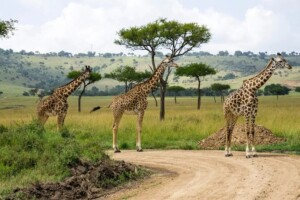

Rewilding tourism is an emerging form of responsible travel that actively supports the restoration of ecosystems and the reintroduction of native species. It goes beyond traditional ecotourism by directly contributing to wildlife conservation efforts aimed at returning landscapes to their natural state, including bringing back keystone species that were once driven out by human activities, like wolves, bison, and large predators.
How Travelers Can Support Rewilding Tourism:
- Choose Rewilding-Focused Destinations: Travelers can visit national parks, reserves, and conservation areas that are dedicated to rewilding efforts. These areas often involve the reintroduction of endangered species and the regeneration of natural habitats. Examples include:
- Yellowstone National Park (USA): Known for its successful wolf reintroduction, which has helped restore the balance of the ecosystem.
- The Scottish Highlands (UK): Where efforts are underway to restore large herbivores and reforest ancient landscapes.
- The Maasai Mara (Kenya): This supports lion and elephant conservation efforts, crucial for the region’s biodiversity.
- David Sheldrick Elephant Orphanage (Kenya): Become a part of our foster family by adopting an orphan elephant, rhino or giraffe.
-
Stay at Conservation-Minded Lodges: Many eco-lodges and safari camps are directly involved in rewilding initiatives. By staying at these accommodations, travelers are funding conservation projects and ensuring that tourism revenue supports local ecosystems and wildlife. Some lodges reinvest profits into anti-poaching units, wildlife monitoring, or habitat restoration.
-
Participate in Wildlife Monitoring or Conservation Activities: Some rewilding tourism experiences allow travelers to get hands-on, participating in activities like animal tracking, wildlife monitoring, and even helping conservationists with species reintroduction efforts. This allows tourists to actively contribute to the recovery of fragile ecosystems while learning about the science of rewilding.
-
Support Organizations Involved in Rewilding: By choosing tour operators and lodges that are partnered with conservation organizations or non-profits, travelers can make sure their money is helping fund ongoing rewilding efforts. Many operators work closely with local governments and communities to create sustainable environments for both people and wildlife.
-
Engage with Local Communities: Successful rewilding involves not just animals and ecosystems but also people. Engaging with local communities and supporting projects that benefit both the environment and the livelihoods of indigenous populations ensures that rewilding is sustainable in the long term. Tourism dollars help provide alternative sources of income for communities, reducing reliance on activities like poaching or overgrazing.
The Impact of Rewilding Tourism:
Rewilding projects aim to restore natural ecosystems by encouraging the return of species that are vital to maintaining biodiversity. This has numerous benefits:
- Improved Biodiversity: Bringing back species like large predators or herbivores has cascading effects on ecosystems, improving overall biodiversity.
- Ecosystem Resilience: Healthier ecosystems are more resilient to environmental changes, including climate change.
- Economic Sustainability: Rewilding tourism provides sustainable economic opportunities for local communities, reducing the pressure on natural resources and helping fund long-term conservation efforts.
Rewilding tourism gives travelers a unique opportunity to not only witness the beauty of nature but to actively participate in its restoration and protection.